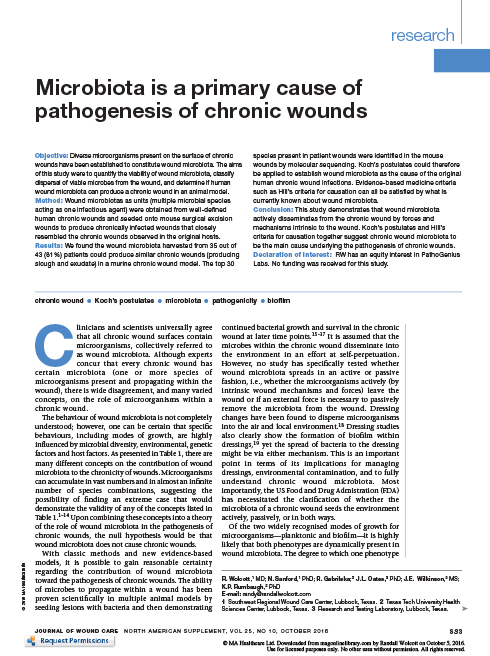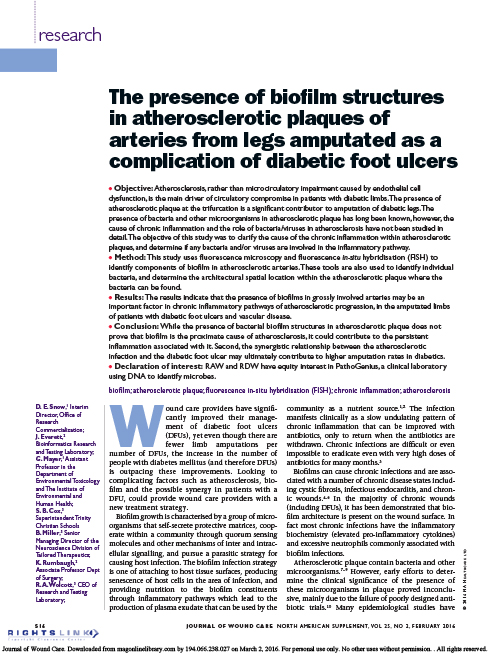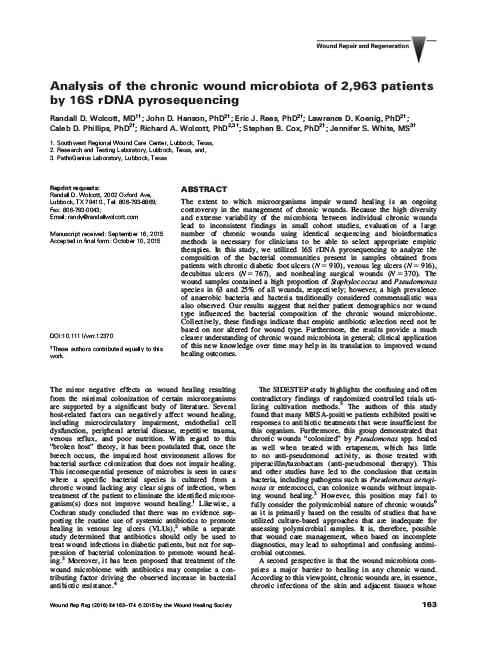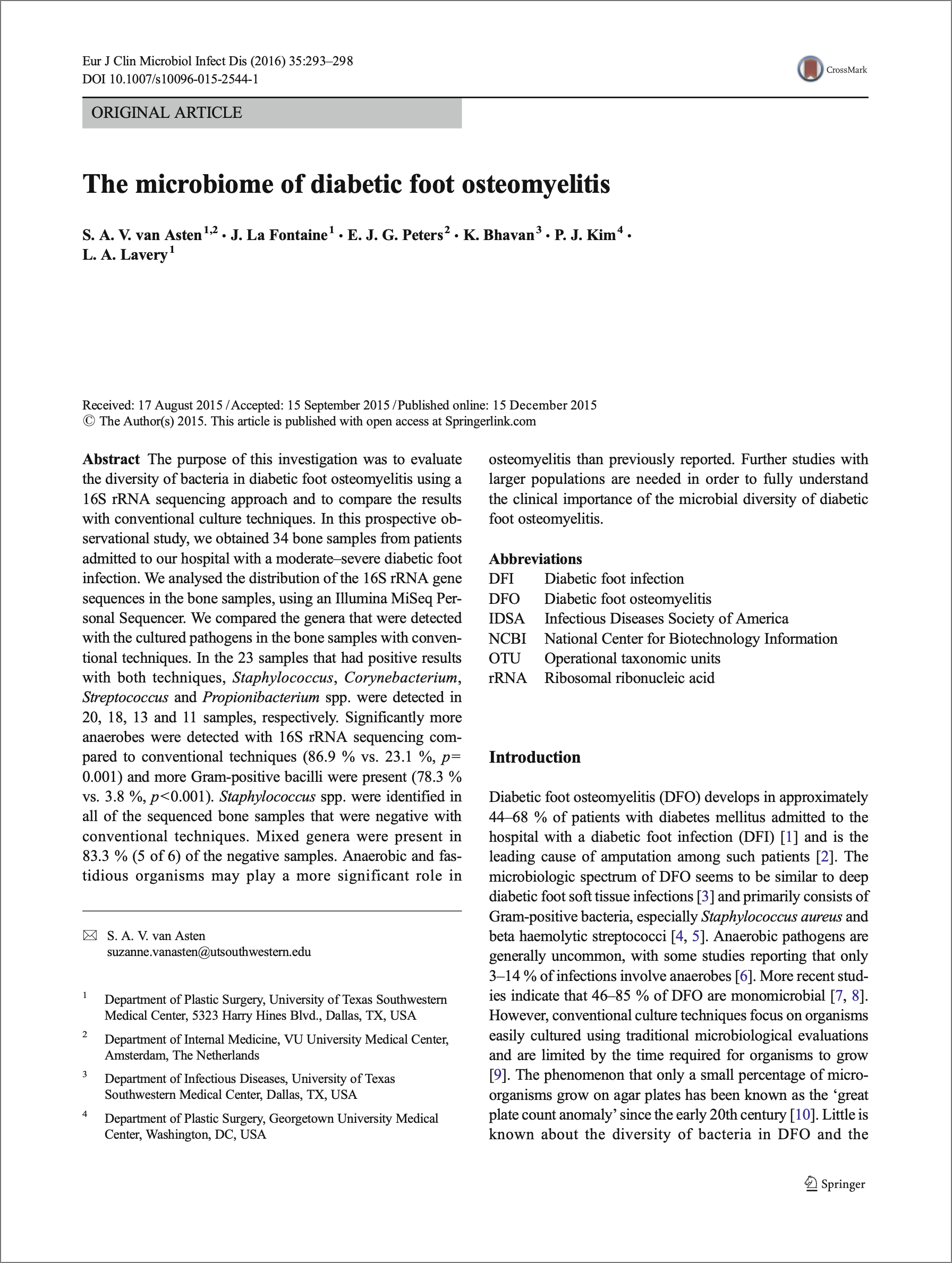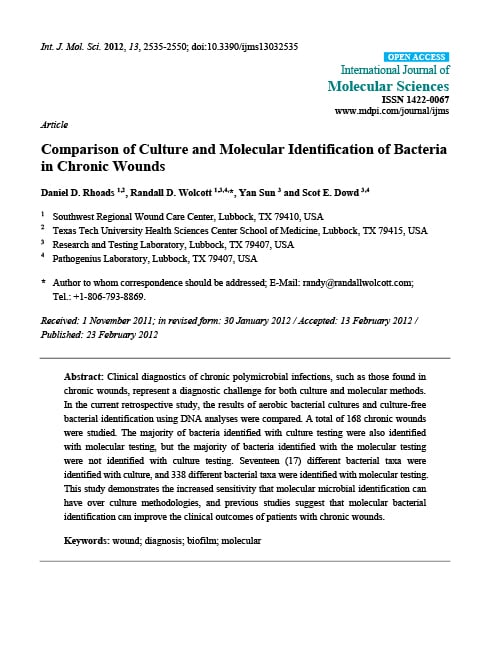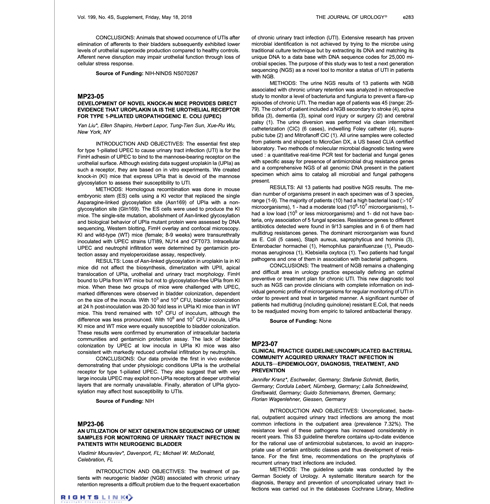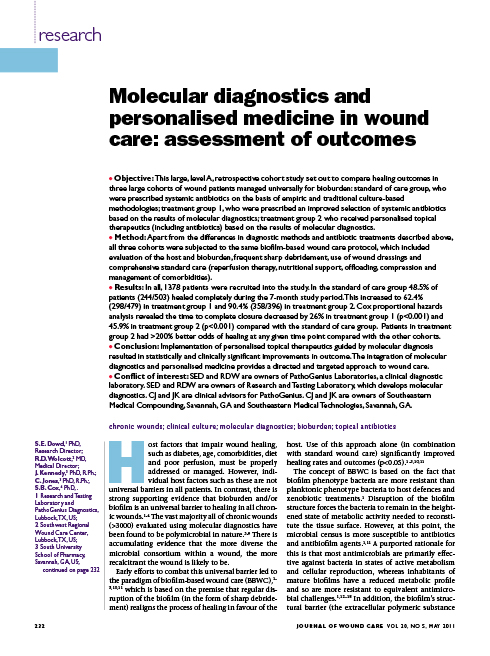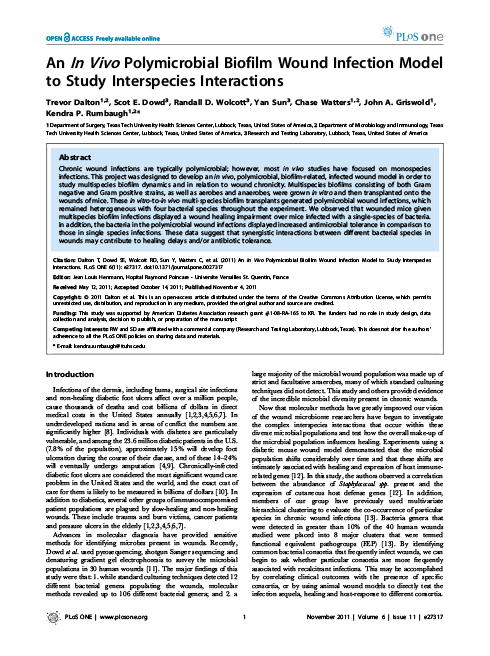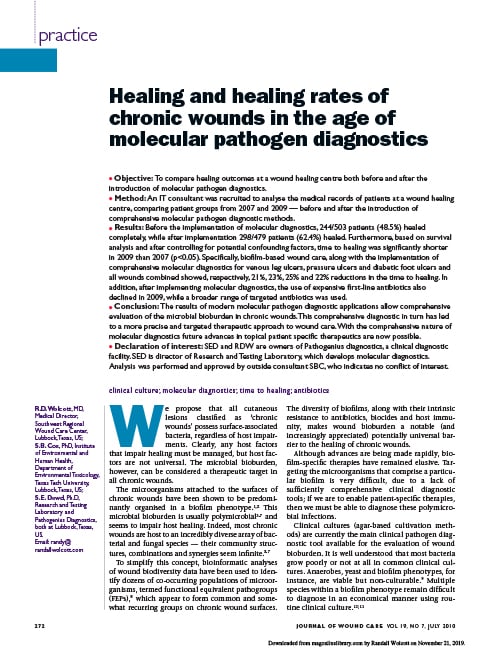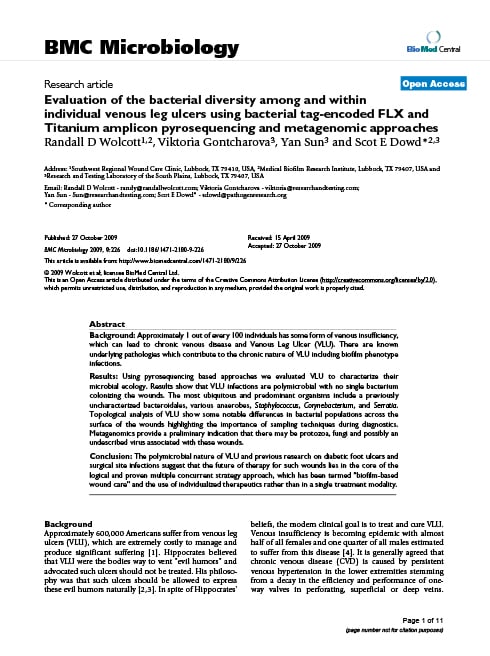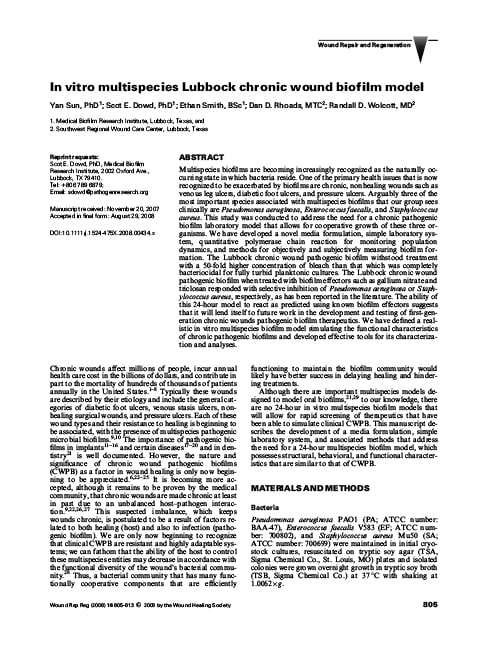Published Studies
Microbiota is a primary cause of pathogenesis of chronic wounds.
J Wound Care. 2016;25(Sup10):S33-S43.
Research Article: 35 out of 43 (81%) wound microbiota harvested from patients produced similar chronic wounds (producing slough and exudate) in a murine chronic wound model. The top 30 species present in patient wounds were identified by molecular sequencing in the seeded mouse wounds. These results demonstrate that wound microbiota actively disseminates from the chronic wound by forces and mechanisms intrinsic to the wound. Koch's postulates and Hill's criteria for causation together suggest chronic wound microbiota to be the main cause underlying the pathogenesis of chronic wounds. Read Article
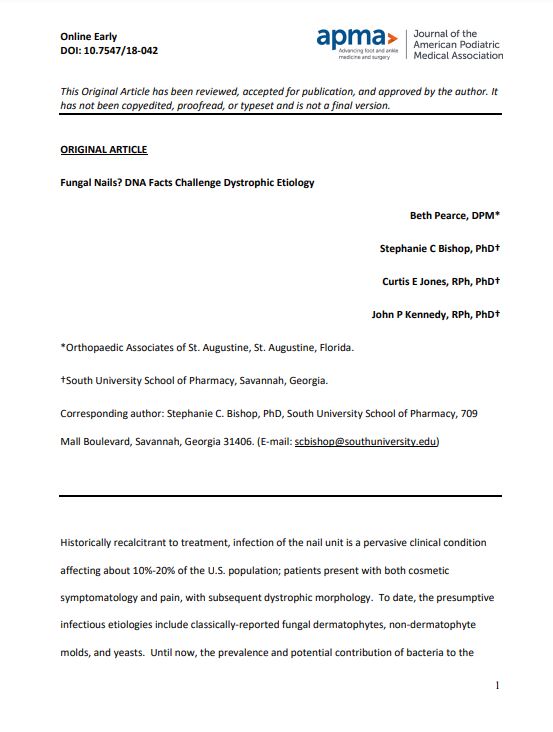
Fungal Nails? DNA Facts Challenge Dystrophic Etiology
JAPMA Volume 112: Issue 2
Research Article: Nail unit infections have historically been difficult to treat, affecting around 10% to 20% of the US population and causing cosmetic concerns, pain, and dystrophic changes. While fungal agents have been widely recognized as the main culprits, bacterial involvement in the clinical course of dystrophic nails has been overlooked or disregarded. Traditional diagnostic methods relied on clinical presentation, microscopic examinations, or PCR assays, each with its limitations. However, with the advancement of molecular-age medicine, DNA-based tools now offer rapid and accurate sequencing of any known microbe or pathogen. In this article, DNA sequencing-based diagnostics revealed the presence of significant bacterial pathogens, challenging the prevailing mycotic-based assumptions and raising questions about current treatment standards. These new findings have the potential to reshape our understanding and management of nail infections. Read Article
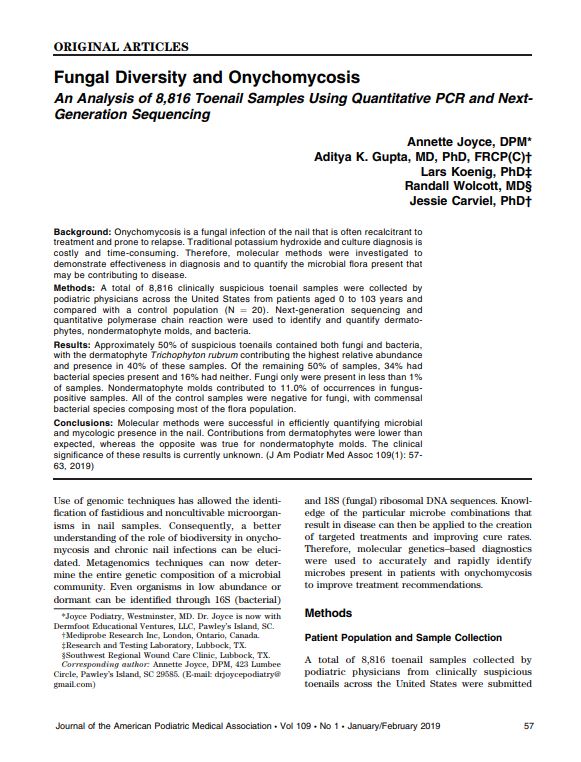
Fungal Diversity and Onychomycosis
JAPMA Volume 109: Issue 1
Research Article: Onychomycosis, a challenging fungal nail infection, often resists treatment and can relapse. Traditional diagnostic methods like potassium hydroxide and culture are time-consuming and costly. To address this, researchers explored molecular techniques for diagnosis and quantifying the microbial flora that might contribute to the disease. They collected 8,816 clinically suspicious toenail samples from patients aged 0 to 103 years across the US, along with 20 control samples. Next-generation sequencing and quantitative polymerase chain reaction were used to identify and measure dermatophytes, nondermatophyte molds, and bacteria. The results revealed that around 50% of suspicious toenails contained both fungi and bacteria, with the dermatophyte Trichophyton rubrum being the most abundant, present in 40% of these samples. The remaining 50% had either bacterial species (34%) or neither fungi nor bacteria (16%). Fungi alone were present in less than 1% of samples, and nondermatophyte molds accounted for 11.0% of occurrences in fungus-positive samples. In contrast, all control samples were negative for fungi, mainly comprising commensal bacterial species. In conclusion, molecular methods efficiently quantified microbial and mycologic presence in the nails. Surprisingly, contributions from dermatophytes were lower than expected, while nondermatophyte molds had a more significant presence. The clinical implications of these findings are yet to be fully understood. Read Article
The presence of biofilm structures in atherosclerotic plaques of arteries from legs amputated as a complication of diabetic foot ulcers.
J Wound Care. 2016;25(2):S16-S22.
Research Article:The study used Fluorescence microscopy and fluorescence in situ hybridization (FISH) to identify potential inflammatory bacterial and viral components of biofilm in atherosclerotic arteries as an investigation into the cause of the chronic inflammation within atherosclerotic plaques of arteries from legs amputated as a complication of diabetic foot ulcers. The results indicate that the presence of biofilms in grossly involved arteries may be an important factor in chronic inflammatory pathways of atherosclerotic progression, in the amputated limbs of patients with diabetic foot ulcers and vascular disease. Read Article
Analysis of the chronic wound microbiota of 2,963 patients by 16S rDNA pyrosequencing.
Wound Repair Regen. 2016 Jan-Feb;24(1):163-174.
Research: The study utilized 16S rDNA pyrosequencing to analyze the composition of the bacterial communities present in samples obtained from patients with chronic diabetic foot ulcers (N = 910), venous leg ulcers (N = 916), decubitus ulcers (N = 767), and nonhealing surgical wounds (N = 370). All wound types examined in the study exhibited similar levels of microbial diversity and abundance at a genus level. Neither patient demographics nor wound type influenced the bacterial composition of the chronic wound microbiome. Staphylococcus and Pseudomonas were the two most frequent bacterial genera identified, however significant variability was observed in their abundance. Staphylococcus was the most frequent bacterial genus present in the polymicrobial communities of the chronic wound samples tested; of these, 40% were methicillin‐resistant. Pseudomonas spp. were present in 25% of all wound samples analyzed. Strict anaerobes comprised four of the top 10 genera detected in the chronic wound samples. Read Research
The microbiome of diabetic foot osteomyelitis
European Journal of Clinical Microbiology & Infectious Diseases 35, 293–298(2016)
Research Article: Analyzing 34 bone samples from patients with moderate to severe foot infection, 16s rRNA NGS sequencing detected significantly more anaerobes (87% vs 23%, p=0.001) and more Gram-positive bacilli than culture. This suggests that anaerobic and fastidious organisms play a more significant role in osteomyelitis than previously believed. Read Article
Comparison of culture and molecular identification of bacteria in chronic wounds.
Int J Mol Sci. 2012;13(3):2535-2550.
Comparative Retrospective Study: A total of 168 chronic wounds were studied, using both aerobic bacterial cultures and culture-free DNA analysis. Seventeen (17) different bacterial taxa were identified with culture, and 338 different bacterial taxa were identified with molecular testing. The majority of bacteria identified with the molecular testing were not identified with culture testing; many of these bacteria were obligate anaerobes. In the majority of the samples, culture underreported the diversity of the wound microbiota and failed to detect the most abundant bacteria in the wound. This study demonstrates the increased sensitivity that molecular microbial identification can have over culture methodologies. Read Study
Clinical identification of bacteria in human chronic wound infections: culturing vs. 16S ribosomal DNA sequencing.
BMC Infect Dis. 2012;12:321-329
Comparative Study: Parallel samples from 51 chronic wounds were studied using aerobic culturing and 16S DNA sequencing for the identification of bacteria. Compared to 16S DNA sequencing, aerobic culture detected only half of the bacteria determined to comprise a dominant portion of the microbiota. At the genus level, molecular testing identified 85% (78/92) of the bacteria identified by culture. Conversely, culturing detected 15.7% (78/497) of the aerotolerant bacteria and detected 54.9% of the collective aerotolerant relative abundance of the samples. Read Study
Molecular diagnostics and personalized medicine in wound care: assessment of outcomes.
J Wound Care. 2011;20(5):232-239.
Retrospective Study: This level A, retrospective cohort study compared healing outcomes in three large cohorts (400-500 patients each) of wound patients managed universally for bioburden: standard of care group, who were prescribed systemic antibiotics on the basis of empiric and traditional culture-based methodologies; treatment group 1, who were prescribed an improved selection of systemic antibiotics based on the results of molecular diagnostics; treatment group 2 who received personalized topical therapeutics (including antibiotics) based on the results of molecular diagnostics. In comparison to the standard of care group, healing rates improved from 48.5% to 62.4% in treatment group 1 and to 90.4% for treatment group 2. The time to complete closure decreased by 26% in treatment group 1 (p<0.001) and 45.9% in treatment group 2 (p<0.001) compared with the standard of care group. Patients in treatment group 2 had >200% better odds of healing at any given time point compared with the other cohorts. Read Study
An in vivo polymicrobial biofilm wound infection model to study interspecies interactions.
PLoS One. 2011;6(11):e27317.
Research Article: Multispecies biofilms consisting of both Gram negative and Gram positive strains, as well as aerobes and anaerobes, were grown in vitro and then transplanted onto the wounds of mice. Wounded mice given multispecies biofilm infections displayed a wound healing impairment over mice infected with a single-species of bacteria. In addition, the bacteria in the polymicrobial wound infections displayed increased antimicrobial tolerance in comparison to those in single species infections. These data suggest that synergistic interactions between different bacterial species in wounds may contribute to healing delays and/or antibiotic tolerance. Read Article
Healing and healing rates of chronic wounds in the age of molecular pathogen diagnostics.
J Wound Care. 2010;19(7):272-281.
Study: The study compares healing rates and healing time of two cohorts, one before implementation of molecular diagnostics, one after. Each cohort consisted of ~500 patients with various wound types. The introduction of molecular pathogen diagnostics, with a corresponding precise and targeted therapeutic approach, improved healing rates from 48.5% to 62.4% and reduced healing time by >20% across wound types. Read Study
Evaluation of the bacterial diversity of pressure ulcers using bTEFAP pyrosequencing.
BMC Medical Genomics. 2010;3:41-52.
Research Article: Bacterial tag-encoded FLX amplicon pyrosequencing was used to identify the bacterial populations in 49 decubitus ulcers. Decubitus ulcers are shown to be polymicrobial, highly variable (228 genera identified among 49 ulcers) microbial communities dominated by 3 to 10 microorganisms, with obligate anaerobes found in significant proportion. In the decubitus ulcers of diabetics the microbial populations and composition may be significantly different from the communities in non-diabetics. The highly unique profile of each individual wound would require a therapeutic approach tailored to the patient's respective wound microflora and traditional culture is largely inadequate in determining the microbial composition of many chronic wounds. Read Article
Evaluation of the bacterial diversity among and within individual venous leg ulcers using bacterial tag-encoded FLX and Titanium amplicon pyrosequencing and metagenomics approaches.
BMC Microbiology. 2009;9:226-237.
Research Article: A pyrosequencing approach was used to characterize the microbial ecology of 40 venous leg ulcer (VLU) samples. Results show that VLU infections are polymicrobial with no single bacterium colonizing the wounds. The most ubiquitous and predominant organisms include previously uncharacterized bacteroidales, various anaerobes, Staphylococcus, Corynebacterium, and Serratia. Topological analysis of VLU show some notable differences in bacterial populations across the surface of the wounds, highlighting the importance of sampling techniques during diagnostics. Metagenomics provide a preliminary indication that there may be protozoa, fungi and possibly an undescribed virus associated with these wounds. Read Article
Survey of bacterial diversity in chronic wounds using Pyrosequencing, DGGE, and full ribosome shotgun sequencing.
BMC Microbiology. 2008;8:43-58.
Research Article: A survey was conducted of major bacterial populations which occur in the pathogenic biofilms of three chronic wound types: diabetic foot ulcers (D), venous leg ulcers (V), and pressure ulcers (P). The study used 3 separate 16S-based molecular amplifications followed by pyrosequencing, shotgun Sanger sequencing, and denaturing gradient gel electrophoresis. The survey study revealed that a wide variety of bacteria with different physiological and phenotypic preferences are common as part of pathogenic biofilm communities in chronic wounds. However, different types of wounds may have different bacterial populations that are prevalent, such as pressure ulcers in which 62% of the populations were identified as obligate anaerobes. Culturing failed to identify major contributing populations, especially strict anaerobes, within the given wound types. Read Article
In vitro multispecies Lubbock chronic wound biofilm model.
Wound Repair and Regeneration. 2008;16(6):805-813.
Research: The study addresses the need for a chronic pathogenic biofilm laboratory model that allows for cooperative growth of three commonly seen organisms: Pseudomonas aeruginosa, Enterococcus faecalis, and Staphylococcus aureus. The study developed a novel media formulation, simple laboratory system, quantitative polymerase chain reaction for monitoring population dynamics, and methods for objectively and subjectively measuring biofilm formation. The 24‐hour model reacts as predicted using known biofilm effectors, lending itself to future work in the development and testing of first‐generation chronic wounds pathogenic biofilm therapeutics. Read Research
Polymicrobial Nature of Chronic Diabetic Foot Ulcer Biofilm Infections Determined Using Bacterial Tag Encoded FLX Amplicon Pyrosequencing (bTEFAP).
PLoS One. 2008;3(10):e3326.
Research Article: A new bacterial tag encoded FLX amplicon pyrosequencing (bTEFAP) approach was used to investigate the polymicrobial nature of chronic diabetic extremity ulcer infections in 40 patients. The most prevalent bacterial genus associated with diabetic chronic wounds was Corynebacterium spp. Also ubiquitous were obligate anaerobes including Bacteroides, Peptoniphilus, Fingoldia, Anaerococcus, and Peptostreptococcus spp. Other major components of the bacterial communities included commonly cultured genera such as Streptococcus, Serratia, Staphylococcus and Enterococcus spp. We introduce the concept of functional equivalent pathogroups (FEP) as consortia of genotypically distinct bacteria that symbiotically produce a pathogenic community. Together, individual members may synergistically cause disease when in an FEP, giving the biofilm community the factors necessary to maintain chronic biofilm infections. The results suggest that traditional culturing methods may be an extremely biased diagnostic tool, as they select for easily cultured organisms such as Staphylococcus aureus and against difficult to culture bacteria such as anaerobes, which data suggests are ubiquitous in these diabetic extremity ulcer chronic wounds. Read Article

